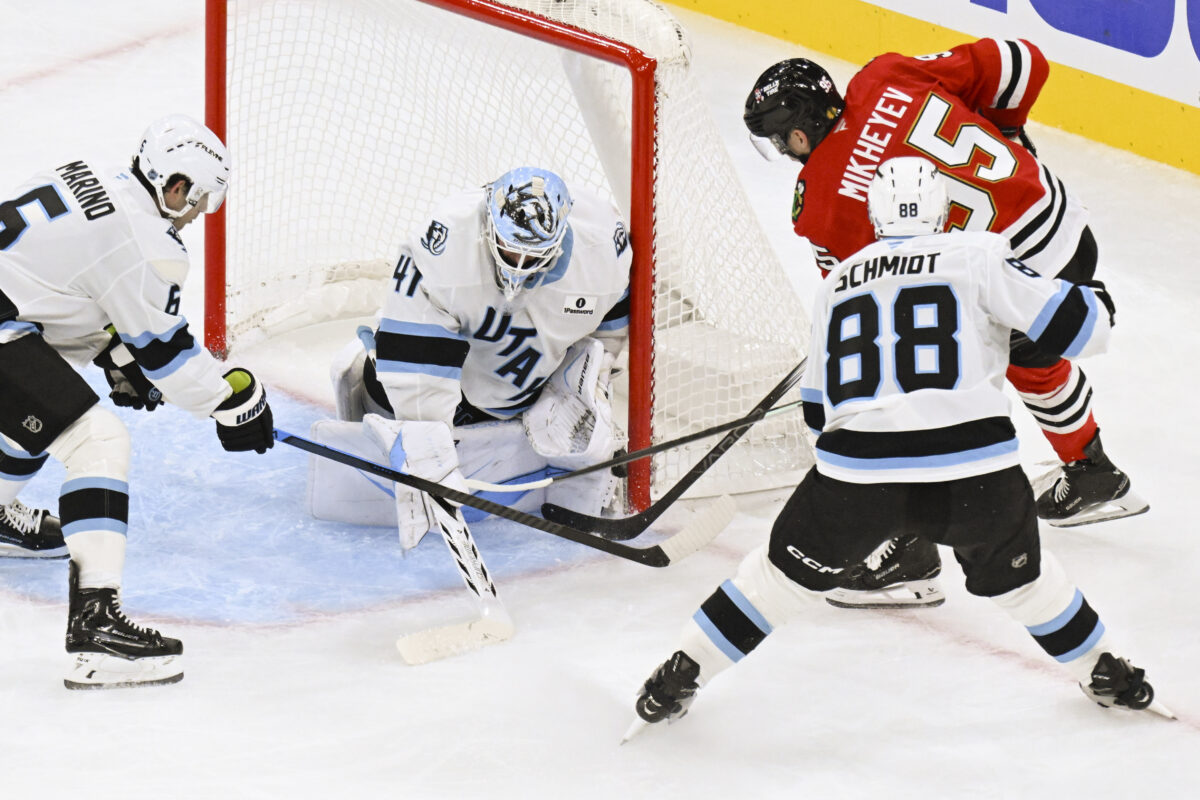After winning three straight games at the newly renovated Delta Center, the Utah Mammoth have allowed the fourth-fewest goals, the fewest shots per game and have the fourth-best expected goal percentage in the NHL at five-on-five through six games.
Related: 3 Takeaways From Mammoth’s 3-2 Win Over Bruins
However, there was immediate concern in the Mammoth’s second game against the Nashville Predators when Sean Durzi took a hard hit in overtime of their first win of the season. He immediately went to the bench favoring his shoulder.
If you remember, the Mammoth defenseman missed more than half of last season after recovering from shoulder surgery. Ultimately, the Mammoth announced that Durzi would be out four weeks with an upper-body injury, a somewhat sigh of relief considering what it could have been.
Last season, when Durzi went down, it caused plenty of instability on the Mammoth’s blue line, which started the season banged up. However, since he has gone down this season, it has not seemed to affect the Mammoth. Which is not a knock on Durzi, but rather a testament to what a good job general manager Bill Armstrong has done rebuilding this blue line over the last two seasons.
Durzi’s Injury Caused Chaos on Utah’s Blue Line Last Season
Last season, Durzi went down in the Mammoth’s fourth game of the season against the New Jersey Devils. At the time, they were already dealing with an injury to the newly acquired John Marino.
In the game after Durzi’s injury last season, Utah was forced to dress Robert Bortuzzo and Vladislav Kolyachonok, who were only trusted with 10:57 and 12:20 per game last season, respectively. Despite a long career, Bortuzzo was on his last legs in the league, while Kolyachonok hasn’t been able to make the jump to the NHL despite getting chances in four straight seasons.
Having these two in the game consistently on the back end forced Armstrong’s hand into making a move. First, he got desperate and dipped into their own prospect pool, calling up Maveric Lamoureux, who shone in his first few games in the NHL.
Regardless of his solid performances and the hype around him, it was a shocking move considering he had dealt with several injuries, making him miss the majority of his next two junior seasons after being drafted in the first round of the 2022 NHL Entry Draft.
Even with Lamoureux stepping in, Utah needed more to stabilize their blue line. Armstrong did that by going out and acquiring Olli Määttä from the Detroit Red Wings at the end of October.
It took nearly a month, but Utah stabilized their defensive core long enough to get both Durzi and Marino back in the lineup while still in a position to push for the playoffs in the back half of the season.
Mammoth Were Prepared for Blue Line Injuries This Season
To start the season, the Mammoth were healthy and not missing anyone, which already put them in a better spot than a year ago.
Even with the injury to Durzi, the Mammoth haven’t had to call on any of their insurance, as they started the season playing a seven-defensemen lineup. The two moves that started the depth on this blue line were the trades for Määttä and Nick Desimone, who was excellent as the Mammoth’s seventh defenseman in the second half of last season.
Their blue line depth has also been bolstered by the emergence of Dmitri Simashev, the Mammoth’s sixth overall pick from the 2023 NHL Entry Draft. Even further, the Mammoth went out and signed Nate Schmidt and Scott Perunovich in free agency to boost their defensive depth.

They may have entered the season with eight defensemen. However, with everyone we’ve discussed, along with potentially Artem Duda, who the Mammoth gave a lot of ice time to throughout training camp, and Nate Schmidt, a Stanley Cup champion the Mammoth signed in free agency, they have 11 defensemen capable of playing minutes in the NHL.
Bill Armstrong Has Completely Transformed This Blue Line
If you look back at the Arizona Coyotes’ final season, where they allowed the eighth-most goals and sixth-most expected goals per game, the only defenseman on the team from that season is Durzi. Since that last season in Arizona to now, the Mammoth have gone from allowing 3.31 goals per game to just 2.15 goals per game through their first six games this season.
A lot of this has to be attributed to Armstrong acquiring Mikhail Sergachev, Marino and Määttä in different trades and signing Schmidt and Ian Cole in free agency over the past two seasons.
Armstrong looks to have built one of the best defensive cores in the NHL, and it has only taken him two seasons to do it. The Mammoth have yet to allow more than three goals in any of their first six games. If they keep that up consistently, this blue line and their defensive structure will elevate this team into the playoffs.
